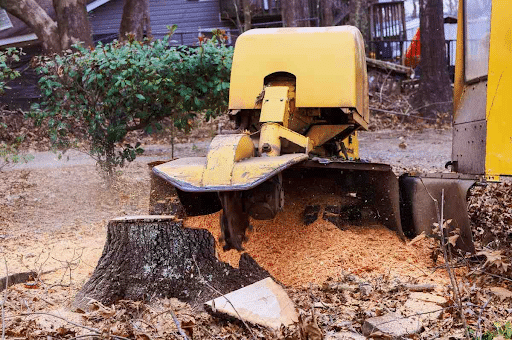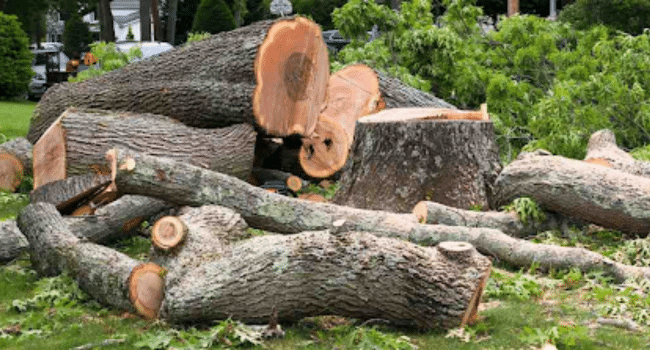Table of Contents
It’s a bright day and the skies are clear. It has been weeks since you’ve cleared a spot in your garden. You’ve removed the tree, but the work isn’t finished. The leftover tree stump may look harmless, yet it’s a safety hazard for feet and mower blades, and a hit on the look of your yard.
Leaving it alone can invite pests or make maintenance harder than it needs to be. Stump grinding steps in as the better fix, breaking down what’s left beneath the surface for a smoother, safer, and easier-to-manage outdoor space.
Why Tree Stump Removal is Non-Negotiable
Leaving a tree stump behind creates more trouble than it’s worth. It turns into a hidden tripping point for kids, pets, and anyone walking across the yard. Mowers and trimmers can catch on the hardwood, leading to bent blades, broken parts, and unexpected repair bills. Beyond safety, old stumps attract unwanted guests like termites, ants, and carpenter bees. Here, tree-care specialists like Payne Tree Services or other yard maintenance businesses can provide professional expertise.
As the wood decays, it can host fungi and diseases that spread to nearby trees or plants. The problem doesn’t stop there. Stumps also limit what you can do with your yard. They block plans for new flower beds, patios, or even a level lawn. What starts as a small leftover piece of a tree quickly becomes a long-term obstacle, affecting the safety, health, and potential of your outdoor space.
Grinding vs. Removal
When a stump needs to go, there are two main routes. Stump removal, or excavation, involves pulling the entire root ball from the ground using heavy equipment like a backhoe or excavator. It clears everything in one go but leaves behind a large hole that demands significant backfilling and cleanup.
Stump grinding takes a different approach. A stump grinder fitted with a rotating, carbide-toothed wheel (grinder teeth) chips away at the wood until it’s reduced to mulch, usually a few inches below ground level. The remaining chips can be left to decompose or used as filler for the spot and root system.
Why Stump Grinding
Here is why stump grinding is more recommended:
1. It’s safer
The use of a stump grinder minimizes heavy digging and large equipment usage compared to excavation (which requires backhoes or excavators). Grinding creates a manageable cavity below grade, reducing the immediate hazard of a large, deep hole left by full removal.
2. It’s cleaner
A stump grinder simply reduces the stump to wood chips (mulch) and dirt, which can be easily used or hauled away. Full removal pulls up the entire root ball, leaving a large mess of mud, rocks, and debris, requiring significantly more cleanup and site restoration.
3. It’s more effective
For a homeowner’s primary goal, reclaiming the yard and planting grass, grinding is the most efficient. It removes the stump far enough below the surface (4-12 inches) to eliminate the hazard and allow new lawn or garden beds, without the massive disruption and expense of removing every single lateral root.
A Step-by-Step Guide to the Grinding Process
Before grinding starts, preparation is key. The area around the stump should be cleared of rocks, branches, and loose items that could interfere with the equipment. It’s also important to mark any underground utilities. Calling 811 in the US or using the Before You Dig Australia (BYDA) online request system ensures nothing hidden gets damaged. Protective tarps or barriers help contain wood chips and prevent debris from scattering across the yard.
Safety gear is essential. The operator of the stump grinder must have ear protection, safety glasses, and personal protective equipment.
Once everything’s ready, the stump grinder is positioned over the stump. The operator lowers the spinning cutter wheel or grinder teeth onto the highest point and begins moving it side to side, gradually shaving down the wood. Each pass removes more material until the stump sits level with or below the ground.
The process continues until the wood is ground four to twelve inches deep, depending on how the space will be used afterward. Lateral roots are also trimmed during this stage, leaving the area smooth, clean, and ready for new growth or landscaping.

Post-Grinding Tips, Cleanup, and Restoration
After grinding, the work shifts to cleanup and repair. The cavity left behind is usually filled with a mix of soil and wood chips from the grinding process. These grindings can stay in place temporarily, be reused as wood chip mulch in garden beds, or be hauled away if a cleaner finish is preferred.
To restore the site, topsoil or compost is added to fill any remaining gaps and bring the ground to the same level as the surrounding area. This step sets the stage for reseeding grass or laying fresh sod right away. If replanting a tree, it’s best to choose a new spot—grinding dust lacks the nutrients and structure young roots need to thrive. A little patience here helps the space recover fully and grow back stronger.
Conclusion
Tree stump grinding finishes what tree removal starts, giving you a safer, cleaner yard without the mess or effort of full excavation. It’s the most efficient way to deal with what’s left behind, leaving your property ready for fresh landscaping or open space.
Homeowners can rent equipment for a DIY project, though hiring a professional or getting tree removal services often saves time and reduces risk. Once the last chip is cleared and the ground is level, you’re free to reclaim that patch of land, turning it from an eyesore into something you can actually enjoy.
